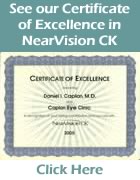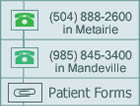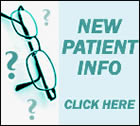
| |
|
|
|
|
|
| |
|
|
|
|
 |
 |
 |
 |
 |
 |
 |
 Download a brochure to learn more about your vision and the Near Vision
CK procedure.
Download a brochure to learn more about your vision and the Near Vision
CK procedure.Click Here Adobe Acrobat Required. Need Acrobat? Click Here |
 |
 |
 |
| Frequently Asked Questions About Near Vision CK |
|
|
How is NearVision CK performed? NearVision CK uses radio waves, instead of a laser or scalpel, to reshape the cornea and bring near vision back into focus. NearVision CK is performed using a small probe, thinner than a strand of human hair, that releases radio waves. The probe is applied in a circular pattern on the outer cornea to shrink small areas of collagen. This circular shrinkage pattern creates a constrictive band (like the tightening of a belt), increasing the overall curvature of the cornea. The procedure, which takes less than three minutes, is done in our CK Suite here at Caplan Eye Clinic with only topical anesthesia (eye drops). Back To Top Will you be cutting the cornea? No. NearVision CK is performed without the cutting or removal of tissue. It is a safe, minimally invasive procedure for baby boomers who struggle to read a newspaper, menu, alarm clock, or computer. Back To Top Is radiofrequency (RF) energy safe for use on the eye? Yes. The use of RF energy is one of today's most advanced surgical techniques. In addition to its use in NearVision CK, RF technology is being used in prostate cancer therapy, back surgery, even cardiovascular procedures. Back To Top Will my vision improve immediately after the NearVision CK procedure? Patients usually notice an immediate improvement in their vision after the NearVision CK procedure. However, it usually takes several weeks for the eyes to adjust to the final level of treatment. Back To Top Will my vision fluctuate after NearVision CK is performed? Most patients will experience mild fluctuation in their vision after the procedure, but few notice it. Any fluctuation will usually subside within a few weeks. Patients who have a procedure to steepen the cornea (presbyopia or hyperopia), regardless of the procedure, usually require a longer stabilization period than those who receive a treatment that flattens the cornea (myopia). Back To Top Are both eyes treated on the same day? NearVision CK is typically performed on just one eye. However, if a patient's prescription requires treatment in both eyes, CK is typically performed on both eyes on the same day - one eye immediately after the other. Most patients are comfortable having the CK procedure performed on both eyes on the same day because the procedure is minimally invasive, takes less than three minutes and is done here at Caplan Eye Clinic with only topical anesthesia. Back To Top Will I have to wear patches over my eyes after the NearVision CK procedure? You will not have to wear patches or bandages. Back To Top How soon can I return to work? With NearVision CK, the majority of patients are able to return to work and other normal activities the day after their procedure. Although recovery is fairly quick, it is advisable to be careful with your eyes and to avoid any strain. Those whose jobs demand intense clarity of vision (such as dentistry, surgery or computer work) may want to give their eyes some extra rest for several days following the procedure before going back to work. Back To Top What type of anesthesia is used during the NearVision CK procedure? A local anesthetic in the form of eye drops is used to numb the eye. Those patients who are nervous or have a high level of anxiety will be given a mild sedative to help them relax. Back To Top What will I feel during the NearVision CK procedure? The NearVision CK procedure is considered painless. You will be aware of a support (speculum), which helps to hold your eye open. The most common sensation that patients experience is a feeling of pressure on the eye. After the procedure, there may be some mild discomfort, and many patients experience a foreign-object sensation or "scratchiness" in the eye. This usually subsides within 24 hours of the procedure. Back To Top Why doesn't NearVision CK use a laser? NearVision CK is a non-laser procedure that uses controlled radio waves to improve near vision. Rather than removing tissue with a laser, NearVision CK reshapes the cornea using an entirely different method: the application of low-level, radiofrequency (RF) energy applied in a circular pattern on the outer cornea, to shrink small areas of corneal tissue. This circular pattern acts like a belt tightening around the cornea to increase its overall curvature and bring life's details back into focus. The procedure, which takes less than three minutes, is done in-office with only topical anesthesia (eye drops). Back To Top Will the instrument used in the NearVision CK procedure penetrate my cornea? NearVision CK is performed using a probe (Keratoplast™ Tip) that is as thin as a strand of human hair. The probe, introduced into the cornea, applies controlled radiofrequency (RF) energy, stabilizes the CK procedure and guarantees the precise depth of treatment. Back To Top How is a precise amount of RF energy and depth of treatment ensured during the NearVision CK procedure? The technology used during the procedure was engineered and designed specifically for performing NearVision CK. This means that the precise amount of RF energy needed to affect the corneal tissue, at the precise tissue temperature and depth of treatment, were meticulously investigated and defined. The Keratoplast™ Tip penetrates the cornea to a depth of 450 µm and utilizes a plastic stop at the very distal portion to assure precise depth of penetration. Back To Top What are the risks and side effects of NearVision CK? Because NearVision CK is minimally invasive, the procedure has exhibited very minimal risk and almost no side effects. During the first 24 to 48 hours after NearVision CK, you may experience tearing and some discomfort, including a foreign-object sensation in the eyes. You may also experience initial slight over-correction of your vision, which stabilizes during the following weeks. However, because NearVision CK doesn't cut or remove tissue, many of the side effects associated with other vision treatment procedures have not been observed with NearVision CK. Back To Top Are there restrictions after having NearVision CK? As with any vision treatment procedure where the cornea is altered, certain precautions should be taken. After the NearVision CK procedure, patients should avoid getting contaminated water in their eyes for at least one week. This includes water from swimming pools, spas, lakes and the ocean. When showering or taking baths, patients should keep their eyes closed in order to avoid getting soap and dirty water into their eyes. When exercising, sweat should be kept out of the eyes for at least a week after the procedure. Also, patients should avoid rubbing their eyes vigorously for two weeks following the procedure. Females should also avoid applying eye makeup for one week after the procedure. Back To Top Am I guaranteed 20/20 vision following NearVision CK? No. And no honest doctor can absolutely guarantee a certain result from any vision treatment procedure. However, in the FDA clinical study, nearly 87% of patients had 20/20 vision while looking at objects in the distance and were able to read phonebook-size print (J3) after having NearVision CK (12-month follow-up data). Back To Top Will I ever need glasses or contacts again? The vast majority of patients do not need corrective lenses for most tasks after the NearVision CK procedure. However, depending on your age and the type of refractive disorder you have, you may need additional vision treatment at some point (surgery, reading glasses or bifocals). This is because your eyes continue to change as you age. Back To Top Is the NearVision CK procedure considered permanent? Both presbyopia and hyperopia are progressive diseases, which means that as people age, their eyes will continue to change - with or without surgical treatment. Back To Top Is NearVision CK reversible? As with most vision treatment procedures, NearVision CK is not reversible. Once the procedure has been performed, it is not possible to "remove" its effects. This is an important factor for anyone thinking about undergoing a vision treatment procedure to carefully consider. To make sure NearVision CK is right for you, call Caplan Eye Clinic to schedule a free CK demonstration. Back To Top Will my health insurance cover the cost of the NearVision CK procedure? Because NearVision CK is considered elective surgery (cosmetic), most health insurance plans do not cover it. Financing options are available to make NearVision CK more affordable. For more information about financing, call our CK counselors at 504-888-2600 (Metairie) or 985-845-3400 (Mandeville). Back To Top Who is NearVision CK right for? You're likely a good candidate for NearVision CK if you:
This is not a complete list of indications and contraindications. If you would like to schedule a free CK demonstration to determine if NearVision CK is right for you, call Caplan Eye Clinic and ask to speak with a CK Counselor. Back To Top Can NearVision CK treat myopia (nearsightedness)? NearVision CK was designed for baby boomers who struggle to read menus, price tags or see their computer — symptoms of fading near vision which require a steepening of the cornea. NearVision CK is not designed to flatten the cornea, the effect required for the treatment of myopia. Back To Top Can NearVision CK be performed on patients who have a pacemaker? The NearVision CK equipment can produce interference that may adversely influence the operation of other electronic equipment. Therefore, NearVision CK is contraindicated for patients who are wearing a pacemaker. Back To Top What enables NearVision CK to be performed in-office? Near Vision CK is a minimally invasive procedure that does not require cutting of the cornea, and therefore does not carry the associated risks or surgical complications. The procedure is relatively quick and easy to perform — taking an average of just 3 minutes. For more information about NearVision CK or to schedule a free CK demonstration, call Caplan Eye Caplan at 504-888-2600 (Metairie) or 985-845-3400 (Mandeville). Back To Top |

|
 |
 |
 |